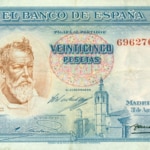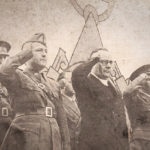A Brief History of BBVA (VII): The Spanish Civil War
The political upheaval that marred and engulfed the country’s public life during the first five years of the 1930s, ended leading Spain right towards where some visionaries’ had predicted it irretrievable would: a full-blown civil war. The succession of controversial events that plagued the first half of 1936 contributed to turn Spanish society into a tinderbox under a stifling political climate. On July 18, General Francisco Franco issued an official statement, announcing the beginning of his uprising against the Second Republic’s current legality.

At that time, it was probably impossible to fathom the level of cruelty wrought in the 32 long months of conflict that followed the coup would end up being. Anything that took place during the three civil wars or the Carlist wars fought in Spain in the last two thirds of the 19th century paled in comparison with the sheer scale of the bloodshed that took place in the battlefields, with the endless mass executions, incarcerations, broken families and orphaned children.
The so-called alzamiento, the full-fledged military coup led and announced by Franco on July 18, 1936, divided Spain into sides, the National and the Republican. And, from that moment onwards, Spain's money also took separate paths.
First monetary measures
On July 19, in the Republican section of the country, a general moratorium on payments and maturities was enacted, strictly forbidding the withdrawal of more than 2,000 pesetas, about €4,500 today. This was undoubtedly a measure that was adopted urgently, given the nature of the situation, in order to try to contain the quick outflow of money. It also sought to prevent the retention of wealth, the obstacle of real production and the possibility of an always undesirable banking panic.

A 25 peseta banknote from August 1936
In the insurgent side, the recently created State Technical Committee limited the right to withdraw funds and values. The Committee also feared there could have been a bank collapse following an eventual mass withdrawal of funds, but Spaniards that lived in the national zone did not think in the same way as the new leadership. And they didn’t based on two reasons: On the one hand, the much lower levels of bankization in the part controlled by the rebels and, on the other hand, the fact that that zone was the most rural part of rural, where agrarian self-sufficiency did not push people to actively seek monetary resources. Just as the Republican authorities did, the nationals established a cap banning withdrawals of more than 2,000 pesetas from banks and savings banks. The measure became effective on July 24, five days after it did in the Republican side.
For its part, the Basque Country was in the midst of shift in the political landscape when the Coup took place. Its recently inaugurated status as autonomous community had strengthened the power of the newly elected lehendakari - the president of the autonomous community - José Antonio Aguirre, who did not hesitate to continue exercising the rights vested on him by the new legal framework that had just been approved. Thus, the regional government seized power over the robust Basque banking fabric and over the rest of the regional industry. Likewise, and in order to remain faithful to republican ideals - with whom they sided, seeing themselves as guarantors of pre-coup legality - they arrogated the right to acquire "as many objects or products as deemed necessary for keeping troops and Civilian population supplied" with the sole endorsement of the Finance Commissioner. In Basque lands demand for money spiked significantly, and Aguirre's government launched a novel method to avoid a shortage of means of payment, dubbed new monetary sign. It consisted of a series of checks issued against the Bank of Spain for the banks and the savings banks that operated in Basque soil. It was a monetary sign that was required to circulate normally and had a validity of one month, being mandatory in the province of Vizcaya.
Moscow Gold
The conflict spread an enormous level of uncertainty among citizens who defended the legality that had been in force until the uprising took place, but also among the leaders of the republican government.
Socialist Juan Negrin, Minister of finance in Largo Caballero’s government, ordered the execution an emergency measure on the September 13. He issued a confidential decree authorizing the transportation of the gold reserves of the Bank of Spain in Madrid to a safe place, given the threat of the insurgent side.

Juan Negrín
The confidential decree, signed by the President of the Republic, Manuel Azaña, and by Negrín himself, read as follows.
Minister of Finance
Your excellency,
The following decree was signed by the President of the Republic, on the 13th day of this present month: The abnormal situation created within the country by the military insurrection compels the government to adopt these precautionary measures considered necessary to safeguard the metallic reserves of the Bank of Spain, basis of the public credit. The nature of the measure itself and the reasons behind its adoption demand that this agreement be kept confidential. Based on the aforementioned considerations, in agreement with the Council of Ministers, and on the proposal of the Ministry of Finance, I hereby ordain, in confidentiality, the following:
- 1º: The Ministry of Finance is hereby authorized to mandate, when considered necessary, the transportation, with the highest guarantees, and to the location esteemed to be the safest, of the gold, silver, and bills present at the time at the central headquarters of the Bank of Spain.
- 2º: The Government will, in due time, provide the pertinent explanations in connection to this decree before the Parliament .
Madrid, 13-9-36.
Dozens of metal workers, locksmiths and trade unionists from Madrid burst into the newly remodeled headquarters of the Bank of Spain and for four intense days they collected the gold and silver reserves deposited there. It is worth noting that, at that time the Bank of Spain, S.A. was still a private entity that treasured precious metals and both public and private deposits.
The destination of the precious metal chosen by Negrín was Moscow. The 700 tons of gold as well as the silver reserves were placed in 10,000 wooden boxes, originally intended for storing ammunition. Once the government's mandate was fulfilled, the gold and silver reserves were transported to the port of Cartagena, where they were kept for about a month, until they finally departed towards the docks of the Soviet town of Odessa. The value of the precious metals shipped in those boxes is estimated to have exceeded 5 billion pesetas of that time, about 18,000 million euros today.
At the end of October, Largo Caballero’s government approved the order mandating the loading of about 7,800 in the four Soviet ships that would carry them to their final destination in Odessa, the final stop before their arrival in Moscow. Another 2,000, however, were taken in half a dozen trucks to Paris. Of the approximately 8,000 boxes comprising the shipment to the USSR, 200 went missing, and were never found. Unlike what happened with the Gold of Moscow, the silver never moved of the province of Murcia and there it remained hidden and in good custody until the end of the conflict. Franco's uprising had only begun a few months earlier, but the reserves of the Bank of Spain’s Madrid headquarters in Plaza de Cibeles had been fully depleted.